How to Care for Poinsettias to Keep Them Alive Past Christmas
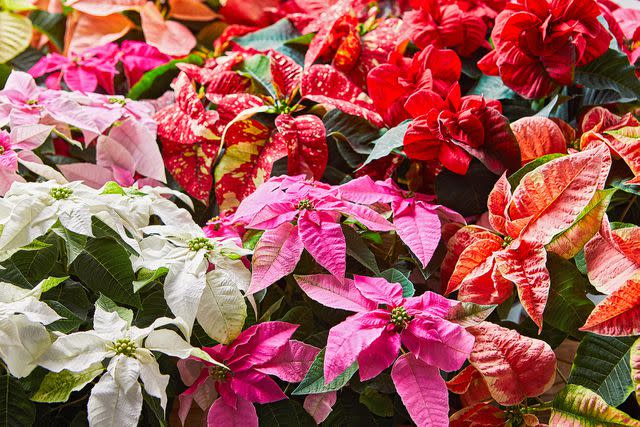
Keep these colorful plants looking their best for as long as possible. And you can even try getting them to rebloom next year.
Poinsettias are absolutely everywhere during the holidays, and for good reason! They're beautiful, festive, and easy to take care of. You can't go wrong with classic red ones (Better Homes & Gardens Red White Poinsettia Mix with Decorative Square Bowl, $39, Walmart), but each year it seems like there are more and more interesting varieties to choose from, too. When you're looking to add these popular plants to your Christmas decor, there are a few tricks to know about how to choose and care for poinsettias that will last through all your merry-making and beyond. And if you're willing to put in the work of keeping them alive until next year, it's possible to get your poinsettias to rebloom in time for another holiday season.
:

How to Choose the Best Poinsettia
Poinsettias might seem short-lived because they usually start dropping their brightly-colored bracts (the modified leaves that often get mistaken for petals) and looking sparse soon after the holidays are over, but today's varieties actually last much longer than they did even a few years ago. Some can hold their color for months instead of just a few weeks. When you're picking out poinsettias to decorate for the holidays, look for plants that have healthy green leaves; they shouldn't be curled, brown, or falling off the lower stem at all. Also, check the real flowers in the center of the bracts. They're tiny, but for long-lasting poinsettias, you want ones that are still tightly closed and don't have any yellow pollen showing yet.
Make sure you look at the plant from all sides before buying to ensure it has a full, almost bush-like shape. Double-checking for pests is a good idea, too. Whiteflies and aphids can sometimes pop up in the greenhouse, so take a quick peek under the leaves of the plant to ensure it's pest-free.
Once you've picked your plants, make sure they're well-protected on the way to your house. Poinsettias are tropical plants that hail from southern Mexico and Central America, so if it's any colder than 50°F outside, make sure you wrap them up before exposing them to the cold air. Take them straight home, too, and don't let them sit in a cold car any longer than they have to, or they could start dropping leaves.
Poinsettia Types
There are well over 100 poinsettia varieties, though you usually won't see such an overwhelming number of choices in stores. Here are some of the most common poinsettias you'll probably see during the holiday season.
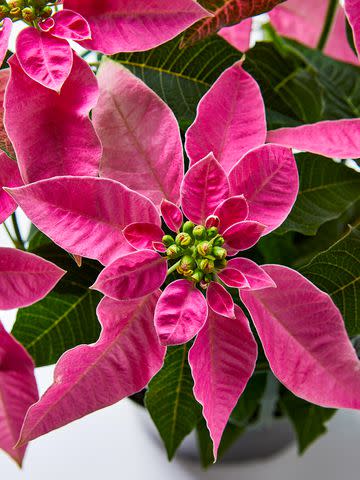
Solid Colors
Plants with solid red bracts are the most popular during the holiday season, but you can find plenty of other fun colors this season, including pink, white, orange, yellow, and even purple.
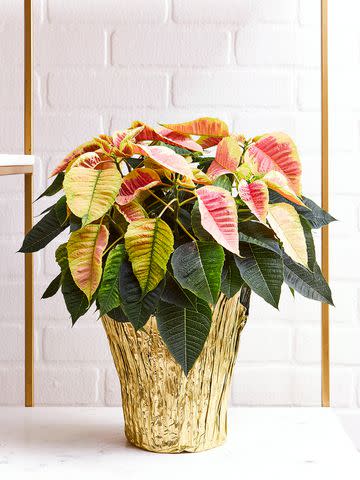
Marble Poinsettias
These plants have gorgeous two-tone bracts that usually feature a darker color like red or pink in the middle, then fade to lighter shades like yellow or cream around the edges.
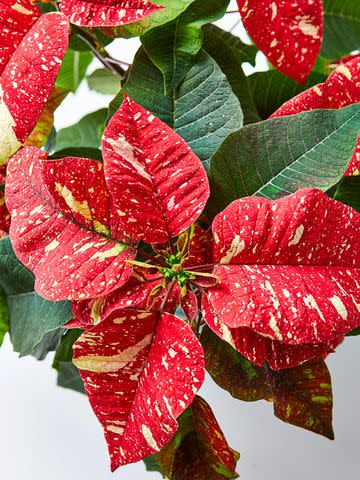
Jingle Poinsettias
Also called glitter poinsettias, these varieties usually have bracts that are one solid color, like red or pink, with white or cream flecks and splotches. These plants are especially eye-catching alongside classic, all-red poinsettias.
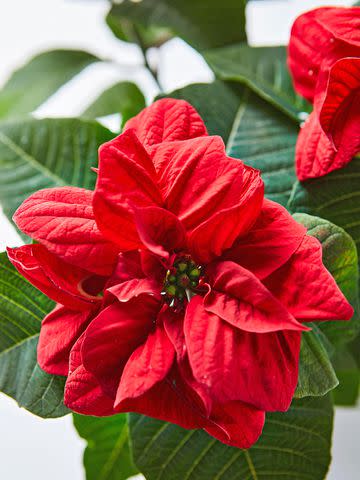
Rose Poinsettias
Rather than the straight, pointed bracts we're used to, rose poinsettias have bracts that curl slightly back and under, making them look like clusters of roses in full bloom. You're most likely to find this type in traditional poinsettia red, but plants with white and pink rose-shape bracts are out there, too.
How to Take Care of a Poinsettia During the Holidays
To keep your poinsettia happy throughout the holiday season, place it in bright, indirect light. Water regularly so that the soil stays evenly moist; if the surface of the soil is dry to the touch, it's time for a drink. Keep a small watering can (try this Better Homes & Gardens .35 Gallon Metal Watering Can, $15, Walmart) nearby to give them a drink anytime the soil is dry. But don't let roots sit in excess water or they can start to rot. This is especially important if you put your poinsettia inside a larger decorative container (known as a cachepot) that doesn't have drainage holes. Place a layer of small rocks on the bottom of the cachepot to hold your poinsettia above any extra standing water.
Keep the temperature between 60-70°F, and watch out for chilly drafts around windows. If your plant is too close to one or exposed to drafts when outside doors are opened, the cold can damage the leaves. Don't be shy about moving your plants around or switching rooms until you find a spot where they are happy.
How to Get Your Poinsettia to Rebloom Next Christmas
Poinsettias are relatively easy to keep alive during the short holiday season, but getting them to rebloom next year is a more challenging undertaking. Once the colorful bracts fade and fall off the plant after the holidays, cut back the stems just below the flowers. You can keep growing them like a houseplant if you like, but in the spring once the temperatures at night are regularly above 50°F, you can place your poinsettias outside if you want. Choose a spot that gets bright, indirect light (somewhere that gets shade in the afternoon would be perfect). You should notice some new growth, but they'll stay completely green all summer.
At the beginning of June, prune back the plants so they're only about six inches tall, and repot them in a slightly larger container with fresh potting soil. Feed them about once a month with half-strength, balanced liquid fertilizer. If you live in a warmer area, like southern California or Florida, you can also plant them in the ground (they can grow to five feet tall or more in these locations). In August, pinch off about an inch from each growing tip to encourage your plants to branch out. If you have any pots outdoors, make sure you bring them inside at the end of the summer before overnight temperatures fall below 60°F.
Then, for about eight weeks, your plants will need about 14-15 hours of uninterrupted darkness every day, and nighttime temperatures around 65°F. This is the trick for triggering new flowers and for the bracts to turn red. Overnight, the plants can't get any light at all; even the crack under a door is enough to disrupt them. Placing them in a closet helps to reduce the amount of light, but to completely eliminate it, you'll want to cover them with something like a box or a blanket. Cover your plants every day around 5 p.m., and uncover them in the morning between 7-8 a.m. During the day, make sure they're still getting plenty of bright, indirect sunlight.
If you're successful, you should start to see your poinsettias developing color by early to mid-November. Once the bracts have started turning red, you can end the ritual of covering them up every night and start caring for them like normal through the holiday season.
Are Poinsettias Poisonous?
Despite what you may have heard, poinsettias aren't harmful if you (or your small child) were to munch a leaf or two, and they're safe to have around pets. Multiple studies have proven that it would take an enormous amount of leaves to hurt you, your kids, or your fur babies. However, poinsettias do have a milky, sticky sap that can irritate the skin and eyes, especially for people with latex allergies. It's a good idea to wear gloves when handling them and wash off any sap that gets on your skin right away, but there's no danger of anyone getting poisoned by contact with these plants.
Decorating with poinsettias always sets a festive mood, and they're relatively low-maintenance houseplants (if you can remember to water your fresh Christmas tree, you can keep a poinsettia alive). They're especially fun to pair with other holiday-themed indoor plants like red succulents and Christmas cacti, or arrange with greens, berries, and baubles. With so many different varieties of poinsettias to choose from, you can create colorful displays to coordinate with just about any style.

